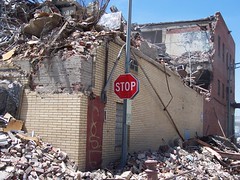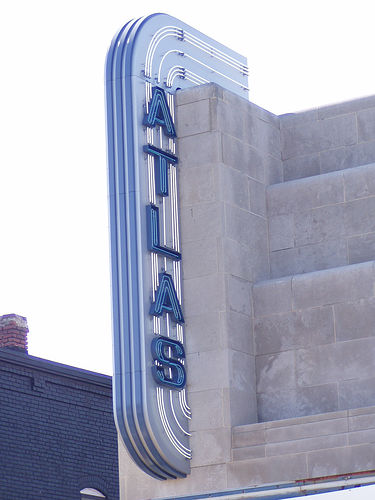Historic preservation (today in DC...)

Stop (Demolition of the U.S. Beef building, 4th and Morse Streets NE)
Originally uploaded by rllayman.
(After a debate this afternoon about how do you define "success" with someone about a particular nomination effort--I said we only won half of what we wanted on one, but he said to count it as a full victory...) I guess I can say that thus far I have an 80% success rate with nominations (although this is due to the assistance of many great people).
Since I dish it out, I can't complain when I have to take it. I will admit that because of the favorable staff report (HPO staff reports are released five days before the hearing), and because architecture was covered in the staff report as well as the original landmark nomination application, I didn't cover architecture in our presentation in great detail. (But it sure covered the "nexus of architecture, place, and social, cultural, and economic history.")
And one of the board members pointed this out, asking the question if the building really merited designation.
I was miffed, and wanted to respond, although the chair waved me off, and another board member, an architect too, as was the original questioner, spoke briefly and in detail about the building and its merits.
And the chair commented about how such nominations are produced by volunteer efforts, by people who aren't necessarily architectural historians, etc.
Had I responded like I wanted I would have said this:
Yes, clearly there is a need for: (1) a thematic survey of theaters; (2) a thematic survey of art deco and art moderne architecture and cultural resources in Washington, DC; (3) even a thematic survey of commercial districts in the city of Washington; and (4) in any case, there should be a comprehensive survey of all cultural resources conducted by the City of Washington. We don't have a comprehensive inventory and it shows so clearly, with questions like that one...
And raising the compelling need for thematic and comprehensive surveys isn't only the job of lay activists, but preservation professionals, including members of the board of the Historic Preservation Review Board.
I am not an archictural historian and I am not familiar with every building in Washington, but I think if I made the following claim that reputable architectural historians would back me up:
The Newton Theater is a particularly fine example of art deco-art moderne architecture in Washington, DC, certainly as an example of movie theaters, definitely as a neighborhood theater, and even when compared more generally to other examples of art deco architecture style throughout the city, including comparison to federal buildings which represent this style, and certainly in comparison to the building that they had just approved immediately before this one (the old Chesapeake and Potomac Telephone Warehouse on the 1100 block of North Capitol Street NE).
The Newton is definitely a particularly fine example for neighborhood theaters, especially in comparison to other theaters in the city built in the two decade period between 1920 and 1940.
 Newton Theater, late 1930s, photo from the collection of Robert K. Headley.
Newton Theater, late 1930s, photo from the collection of Robert K. Headley. Newton Theater today.
Newton Theater today.Furthermore, the HPRB has already approved the H Street Playhouse and the Atlas Theater, and these buildings are now listed on the DC Inventory. I think Tim Dennee, one of the HPO architectural historians and I disagree about the Atlas. I like it, I'm glad it's designated but I think the Newton is a better and more interesting building. (Both the Newton and the Atlas were designed by John Zink in art deco/art moderne style.)
 The Atlas does have a fine neon sign, and I love neon. (Photo by Inked78.)
The Atlas does have a fine neon sign, and I love neon. (Photo by Inked78.)Furthermore, people call the Atlas a neighborhood theater, but in reality it was a theater constructed in a regional commercial district.
At the time the Atlas was built, H Street was the number two general retail district in the region, after downtown -- this is arguable; people on 14th Street NW would argue it was #2, but that is deceptive because 14th Street was the main location for car dealerships and a car cost much more than a pair of shoes, a suit, or an Easter outfit (although H Street had a few car dealerships too, including Ourisman Chevrolet, which at one time was the largest Chevy dealership in the world).
In short, the Atlas was a theater for a regional commercial district, while the Newton is unquestionably a neighborhood theater.
Plus the Atlas was built as the "headquarter" theater for the then developing K & B (Kogod & Burka) theater chain, which existed in the DC region into the 1990s, so it was built as the flagship for the company, and included corporate offices.
I would aver that this would be confirmed by architectural historians if thematic surveys of theaters, of art deco architecture, and of commercial districts were to be conducted in the City of Washington.
_________
Definition of thematic survey: in-field inventory focuses on one property type or one historic context. Thematic surveys must include a detailed description of how the properties to be surveyed are identified and selected.
Index Keywords: historic-preservation



0 Comments:
Post a Comment
<< Home